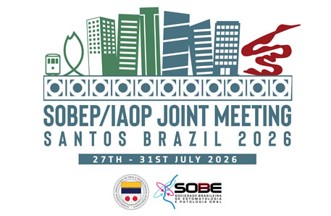Pachyonychia congenita with an unusual intraoral manifestation: case report
DOI:
https://doi.org/10.5327/2525-5711.264Keywords:
Pachyonychia congenita, Skin diseases, Genetic, Leukokeratoses, oral, Oral Medicine, Case reportAbstract
Pachyonychia congenita (PC) is a rare dermatosis impacting skin structures, appendages, and mucous membranes, primarily characterized by nail dystrophy, palmoplantar keratoderma, and plantar pain. Oral manifestation are particularly natal teeth and oral leukokeratosis and may be the earliest clinical signs. There is no specific treatment, the protocols are individualized and aim to alleviate symptoms. A 5-year-old boy came to the dentist's office complaining of a toothache. Intraoral examination revealed diffuse lesions scattered in the hard palate, marginal gingiva, alveolar mucosa, and tongue. Additionally, white plaques were observed on the lips at the boundary between the perilabial skin and the vermilion of the lip. Extraoral examination identified palmar lesions, skin lesions on the elbows and knees, as well as nail thickening and absence on the fingers and toes. Incisional biopsies of the lesion on the palate and on the belly of the tongue were performed and histopathological examination showed subepithelial clefts, dyskeratotic areas, hyperkeratosis, and acanthosis. Based on clinical and microscopic features, the diagnosis of PC (OMIM #167200) was established. Despite the typical skin alterations, the intraoral lesions shown in this case are atypical and uncommon. This case describes a young patient with typical skin and nail alterations and atypical and uncommon intraoral lesions related to PC and emphasizes the significant role of dentists in diagnosing syndromic conditions affecting the mouth.
References
Shah S, Boen M, Kenner-Bell B, Schwartz M, Rademaker A, Paller AS. Pachyonychia congenita in pediatric patients natural history, features, and impact. JAMA Dermatology. 2014;150(2):146-53. https://doi.org/10.1001/jamadermatol.2013.6448
Zieman AG, Coulombe PA. Pathophysiology of pachyonychia congenita-associated palmoplantar keratoderma: new insight into skin epithelial homeostasis and avenues for treatment. Br J Dermatol. 2020;182(3):564-73. https://doi.org/10.1111/bjd.18033
Smith FJD, Hansen CD, Hull PR, Kaspar RL, Irwin McLean WH, O’Toole E, et al. Pachyonychia congenita. In: Gene Reviews. Seattle: University of Washington; 1993. PMID: 20301457.
Mccarthy RL, Brito M, O’Toole E. Pachyonychia congenita: clinical features and future treatments. Keio J Med. 2023. https://doi.org/10.2302/kjm.2023-0012-IR
Eliason MJ, Leachman SA, Feng BJ, Schwartz ME, Hansen CD. A review of the clinical phenotype of 254 patients with genetically confirmed pachyonychia congenita. J Am Acad Dermatol. 2012;67(4):680-6. https://doi.org/10.1016/j.jaad.2011.12.009
Rathore PK, Khullar V, Das A. Pachyonychia congenita type 1: case report and review of the literature. Indian J Dermatol. 2016;61(2):196-9. https://doi.org/10.4103/0019-5154.177761
Agarwal P, Chhaperwal M, Singh A, Verma A, Nijhawan M, Singh K, et al. Pachyonychia congenita: a rare genodermatosis. Indian Dermatol Online J. 2013;4(3):225-7. https://doi.org/10.4103/2229-5178.115527
Daroach M, Dogra S, Bhattacharjee R, Afra T, Smith F, Mahajan R. Pachyonychia congenita responding favorably to a combination of surgical and medical therapies. Dermatol Ther. 2019;32(5):e13045. https://doi.org/10.1111/dth.13045
Cantile T, Coppola N, Caponio VCA, Russo D, Bucci P, Spagnuolo G, et al. Oral mucosa and nails in genodermatoses: a diagnostic challenge. J Clin Med. 2021;10(22):5404. https://doi.org/10.3390/jcm10225404
Leachman SA, Kaspar RL, Fleckman P, Florell SR, Smith FJD, Irwin McLean WH, et al. Clinical and pathological features of pachyonychia congenita. J Investig Dermatol Symp Proc. 2005;10(1):3-17. https://doi.org/10.1111/j.1087-0024.2005.10202.x
Heliotis I, Whatling R, Desai S, Visavadia M. Primary herpetic gingivostomatitis in children. BMJ. 2021;375:e065540. https://doi.org/10.1136/bmj-2021-065540
AlSabbagh MM. Dyskeratosis congenita: a literature review. J Dtsch Dermatol Ges. 2020;18(9):943-67. https://doi.org/10.1111/ddg.14268
Savage SA. Dyskeratosis congenita and telomere biology disorders. Hematology Am Soc Hematol Educ Program. 2022;2022(1):637-48. https://doi.org/10.1182/hema tol ogy.2022000394
Duverger O, Carlson JC, Karacz CM, Schwartz ME, Cross MA, Marazita ML, et al. Genetic variants in pachyonychia congenita-associated keratins increase susceptibility to tooth decay. PLoS Genet. 2018;14(1):e1007168. https://doi.org/10.1371/journal.pgen.1007168
Published
How to Cite
Issue
Section
License
Copyright (c) 2024 Éder Gerardo Santos-Leite, Adrian Eduardo Ramírez Sánchez, José Luis Buentello de la Cruz, Hélen Kaline Farias Bezerra , Ricardo Martínez Pedraza, Hercílio Martelli-Júnior

This work is licensed under a Creative Commons Attribution 4.0 International License.














